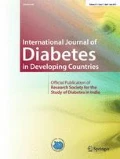Abstract
To identify whether capillary blood glucose measurement at an alternate site (knee) is equivalent to and less painful than capillary blood glucose measured by finger pricking. A randomized crossover trial was performed to compare capillary blood glucose measurements, pain, and preference between puncture sites (finger vs. skin fold of the knee) among 45 children with type 1 diabetes. A standard glucometer was used, and measurements were performed in both a fasting and postprandial state. In the comparison of capillary blood glucose measurements of the knee vs. the finger, we observed a non-significant difference of 5.95 ± 8.19 % and 1.32 ± 26.45 % in the fasting and postprandial states, respectively. Knee puncture was significantly less painful than finger pricking (P < 0.001). Capillary blood glucose levels measured by knee skin pricking are non-significantly lower than those measured by traditional finger pricking. Knee skin pricking is significantly less painful than finger pricking.


References
Karter AJ, Ackerson LM, Darbinina JA, D’Agostina RB, Ferrara A, Liu J, et al. Self-monitoring of blood glucose level and glycemic control: the Northern California Kaiser Permanente Diabetes registry. Am J Med. 2001;111:1–9.
Haller MJ, Stalvey MS, Silvestein JH. Predictors of control of diabetes: monitoring may be the key. J Pediatr. 2004;144:660–1.
Dorchy H, Roggemans MP. Improvement of the compliance with blood glucose monitoring in young insulin dependent diabetes mellitus patients by the Sensorlink system. Diabetes Res Clin Pract. 1997;36(2):77–82.
Pacaud D, Lemay JF, Buithieu M, Yale JF. Blood volumes and pain following capillary punctures in children and adolescents with diabetes. Diabetes Care. 1999;22:1592–4.
Burge MR. Lack of compliance with home blood glucose monitoring predicts hospitalization in diabetes. Diabetes Care. 2001;24(8):1502–3.
Abbot Diabetes Care Inc. Optium mini blood glucose test strips-product information.
International Association for the study of Pain. Faces Pain Scale, ©2001 – Revised [on line article]. http://www.iasp-pain.org/Content/NavigationMenu/GeneralResourceLinks/FacesPainScaleRevised/default.htm. Accesed 10 October 2011.
American Diabetes Association. Standards of medical care 2012. Diab Care. 2012;35(1):S11–63.
American Diabetes Association. Self-monitoring of blood glucose. Diabetes Care. 1994;17(1):81–6.
Bui H, Perlman K, Daneman D. Self-monitoring of blood glucose in children and teens with diabetes. Pediatr Diabetes. 2005;6(1):50–62.
Acknowledgments
MFCP conducted the study, analyzed the data, served as first author of the manuscript, and takes responsibility for its content. SPL provided support in data analysis and manuscript editing. RCL was involved in participant recruitment and review of the manuscript. We thank Itziar Rebollar and Luis Murguía for their collaboration in English editing.
Conflict of interest
This project had no external support or funding, and there are no potential conflicts of interest related to this article.
Author information
Authors and Affiliations
Corresponding author
Rights and permissions
About this article
Cite this article
Castilla-Peón, M.F., Ponce-de-León-Rosales, S. & Calzada-León, R. Knee skin pricking to monitor capillary blood glucose is less painful than finger pricking in children with type 1 diabetes. Int J Diabetes Dev Ctries 35, 620–623 (2015). https://doi.org/10.1007/s13410-015-0342-z
Received:
Accepted:
Published:
Issue Date:
DOI: https://doi.org/10.1007/s13410-015-0342-z

